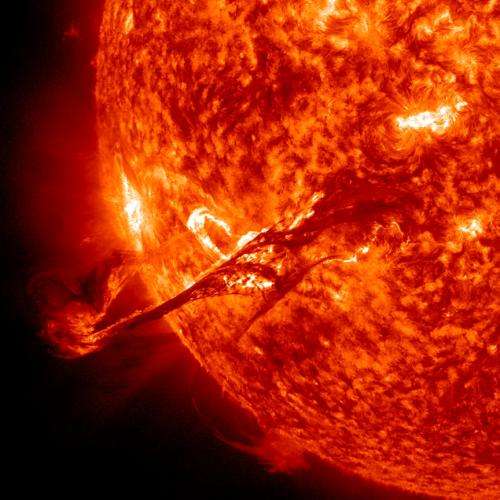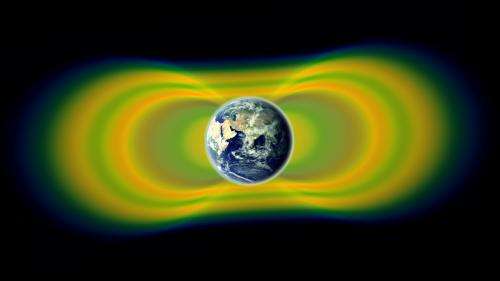Third radiation belt can wrap around Earth, probes reveal

With the flip of a switch, a pair of instruments designed and built by the University of Colorado Boulder and flying onboard twin NASA space probes have forced the revision of a 50-year-old theory about the structure of the radiation belts that wrap around the Earth just a few thousand miles above our heads.
The Van Allen radiation belts—donut-shaped rings of so-called "killer electrons" that encircle the Earth—were the first discovery of the space age. Data sent back from NASA's Pioneer 3 and Explorer IV spacecraft, both launched in 1958 and both carrying instruments built by James Van Allen, showed the presence of two distinct rings of high-energy electrons.
On Aug. 30, NASA launched the Radiation Belt Storm Probes mission, since renamed the Van Allen Probes mission, to learn more about the belts, which are known to be hazardous to satellites, astronauts and technological systems on Earth.
Each probe carries a Relativistic Electron-Proton Telescope, or REPT, designed and built at CU-Boulder's Laboratory for Atmospheric and Space Physics, known as LASP. When CU-Boulder scientists turned on the instruments, just a few days after launch, they were shocked by what they saw unfold: the formation of a third "storage ring" radiation belt.
"It was so odd looking, I thought there must be something wrong with the instrument," said LASP Director Dan Baker, REPT principal investigator and lead author of the study published online today in the journal Science. "But we saw things identically on each of the spacecraft. We had to come to the conclusion that this was real."
The data sent back to Earth from the REPT instruments during the month of September initially showed two Van Allen belts, as expected. But after a few days, the outer ring appeared to compress into an intense, tightly packed electron band and a third, less compact belt of electrons formed further out, creating a total of three rings. The middle "storage ring" persisted as the belt furthest away from Earth began to decay away in the third week of September, until, finally, a powerful interplanetary shockwave traveling from the sun virtually annihilated both the storage ring and the rest of the outer belt.
Scientists have known that the outer Van Allen belt can fluctuate wildly, at times swelling with charged particles before letting them slip away again, depending on space weather. In the months since the storage belt and the outer belt virtually disappeared, the Van Allen radiation zones have re-formed into the originally expected two-belt structure.

"We have no idea how often this sort of thing happens," Baker said. "This may occur fairly frequently but we didn't have the tools to see it."
The fact that NASA's new tools observed the events at all was somewhat serendipitous. When NASA launches a new spacecraft, instruments onboard are turned on, tested and calibrated in a prescribed order. CU-Boulder's REPT instruments were originally scheduled to be turned on about a month after launch, when the third Van Allen radiation belt would have already dissipated. But Baker and his colleagues lobbied to jump the REPT instrument to the front of the instrument commissioning line.
Baker's concern was that the only other NASA sensors collecting similar —though far more rudimentary—data on the Van Allen radiation belts were onboard the 20-year-old Solar, Anomalous and Magnetospheric Particle Explorer, or SAMPEX, mission, which was expected to fall back into Earth's atmosphere and burn up in late 2012.
Baker wanted REPT to collect as much overlapping data with SAMPEX as possible so that the two data records could be more easily stitched together and compared with each other. The REPT researchers won their case, and the instruments powered up on Sept. 1.
"Had we not done so, we would have missed this," Baker said. "It's good to be in the right place at the right time with the right instrument."
The two NASA probes, which are flying around Earth in an elliptical orbit, are able to send back observations for the first time from the heart of the two belts as each probe passes through. The information gathered by the twin, octagonal spacecraft will help researchers better understand how space weather affects near-Earth phenomena by interacting with, feeding and stripping away the Van Allen belts.
A better understanding of belt formation, including the number of belts, will help researchers refine their understanding of how and when solar storms can wreak havoc on Earth.
"We can offer these new observations to the theorists who model what's going on in the belts," said Shri Kanekal, the deputy mission scientist for the Van Allen Probes at NASA's Goddard Space Flight Center in Greenbelt, Md. and a co-author of the new study. "Nature presents us with this event—it's there, it's a fact, you can't argue with it—and now we have to explain why it's the case. Why did the third belt persist for four weeks? Why does it change? All of this information teaches us more about space."
More information: www.nasa.gov/vanallenprobes
A Long-Lived Relativistic Electron Storage Ring Embedded in Earth's Outer Van Allen Belt," by D.N. Baker, Science, 2013. www.sciencemag.org/content/ear … nce.1233518.abstract
Journal information: Science
Provided by University of Colorado at Boulder




















